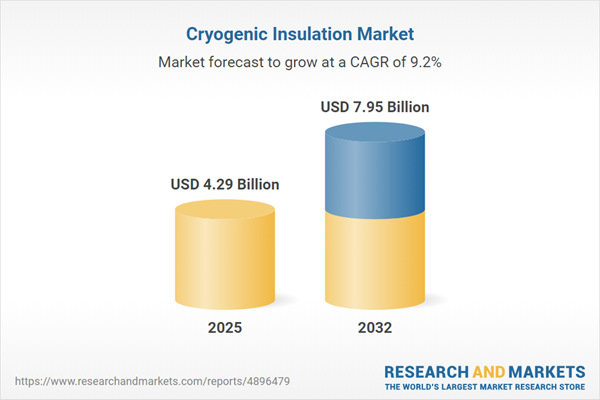Speak directly to the analyst to clarify any post sales queries you may have.
The cryogenic insulation market is experiencing rapid transformation as organizations respond to evolving regulations, next-generation materials, and dynamic supply chain demands. Senior decision-makers face the challenge of integrating innovation with operational stability across international cold chain operations.
Cryogenic Insulation Market Snapshot
Valued at USD 3.92 billion in 2024, the cryogenic insulation market is projected to reach USD 4.29 billion by 2025 and USD 7.95 billion by 2032, reflecting a compound annual growth rate of 9.21%. This growth is propelled by investment in cold chain infrastructure, enhanced thermal protection solutions, and an increased emphasis on regulatory compliance. Industry players are adopting advanced insulation technologies that drive energy efficiency and improve system reliability. Progress in material science enables organizations to adapt quickly to shifting compliance requirements and enhances supply chain resilience throughout key sectors.
Cryogenic Insulation Market: Scope & Segmentation
This executive-level report provides strategic segmentation and analysis to support risk management, procurement, and technology decisions in the cryogenic insulation market. It is structured to link technical enhancements and geographic dynamics to measurable business outcomes:
- End Use Industries: Emphasizes the criticality of modern insulation in ensuring food and beverage safety, optimizing oil and gas operations, maintaining petrochemical process integrity, and complying with pharmaceutical storage standards.
- Material Types: Examines the role of microporous insulation, multilayer reflective barriers, advanced perlite, polyurethane foam, and vacuum-insulated panels in enabling both energy savings and secure containment of cryogenic substances.
- Application Areas: Details the deployment of insulation solutions across onshore and offshore pipelines, various storage environments, transport containers, mobile tankers, and specialized areas such as valves and fittings requiring stringent temperature regulation.
- Regional Coverage: Reviews operational trends and regulatory landscapes across North America, Latin America, Europe, the Middle East, Africa, and Asia-Pacific, considering differing compliance demands and logistical complexities.
- Key Companies Analyzed: Assesses technological integration, supplier management, and distribution models for prominent organizations including Armacell International S.A., BASF SE, Dow Inc., Cabot Corporation, Owens Corning, Aspen Aerogels Inc., Parker-Hannifin Corporation, Evonik Industries AG, GEA Group Aktiengesellschaft, and Zotefoams plc.
Cryogenic Insulation Market: Key Takeaways for Senior Decision-Makers
- Deploying digital analytics enhances transparency throughout cold chain assets, improving risk response and supporting consistent operational oversight.
- Aligning procurement with sustainability and compliance priorities ensures readiness for new regulations and addresses evolving risk profiles.
- Strengthening and diversifying supplier networks increases resilience, minimizing the impact of supply fluctuations or regional disruptions.
- Fostering collaboration between internal technical teams, suppliers, and broader stakeholders accelerates system development and adaptation to industry standards.
- Incorporating advisory and maintenance services extends asset value while helping reduce operational risks across complex infrastructures.
- Moving toward reliability-focused procurement approaches supports predictable performance and stronger supply security in demanding environments.
Tariff Impact: Implications for the Cryogenic Insulation Market
Recent tariffs on specialty polymers and metallic foils in the United States have led to revised sourcing approaches. As organizations build supplier relationships across Europe and Asia-Pacific, they strengthen geographic reach and support innovation. This diversification helps offset abrupt cost pressures, maintaining stable operations and supporting strategic cold chain investments worldwide.
Methodology & Data Sources
The report utilizes secondary research, benchmarking, and consultation with industry experts to ensure data reliability and executive relevance. Established frameworks such as Porter’s Five Forces and SWOT provide context for market evaluation, while independent peer review validates insights.
Why This Report Matters
- Establishes an independent benchmark for adopting insulation technology and meeting compliance expectations across diverse global markets.
- Equips executives to proactively manage regulatory risk and refine procurement strategies amid a changing tariff landscape.
- Informs allocation of resources by clarifying the operational impact of new technical solutions and integrated service models.
Conclusion
This report supports decision-makers in optimizing insulation strategies, achieving compliance, and enhancing resilience in a rapidly evolving market context.
Additional Product Information:
- Purchase of this report includes 1 year online access with quarterly updates.
- This report can be updated on request. Please contact our Customer Experience team using the Ask a Question widget on our website.
Table of Contents
3. Executive Summary
4. Market Overview
7. Cumulative Impact of Artificial Intelligence 2025
Companies Mentioned
The companies profiled in this Cryogenic Insulation market report include:- Armacell International S.A.
- BASF SE
- Dow Inc.
- Cabot Corporation
- Owens Corning
- Aspen Aerogels, Inc.
- Parker-Hannifin Corporation
- Evonik Industries AG
- GEA Group Aktiengesellschaft
- Zotefoams PLC
Table Information
| Report Attribute | Details |
|---|---|
| No. of Pages | 194 |
| Published | November 2025 |
| Forecast Period | 2025 - 2032 |
| Estimated Market Value ( USD | $ 4.29 Billion |
| Forecasted Market Value ( USD | $ 7.95 Billion |
| Compound Annual Growth Rate | 9.2% |
| Regions Covered | Global |
| No. of Companies Mentioned | 11 |









